Article and photos by Joe Sapia
Note: The yard references are to my house in the section of Monroe between Helmetta and Jamesburg in South Middlesex County. My yard is in a Pine Barrens outlier on the Inner Coastal Plain, the soil is loamy, and my neighborhood is on the boundary of Gardening Zones 6b (cooler) and 7a (warmer). Notes and photographs are for the period covered, unless otherwise noted.
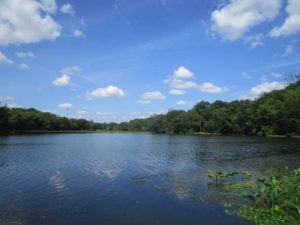
Etra Lake, in East Windsor, Mercer County, sits on the Inner Coastal Plain. Most, if not all, bodies of water on New Jersey’s Inner and Outer Coastal Plains, are human-made – in Etra Lake’s case by the damming of Rocky Brook. Rocky Brook is part of the Raritan River-Bay watershed. The damming of the lake appears to go back to the late 1700s to create a power source to run a grist mill. The name “Etra” actually is an acronym, “ETRA,” after a prominent resident, Edward Taylor Rosel Applegate, born in 1831 and died in 1915.
THE CUESTA: Of New Jersey’s four land regions, two are in the Jersey Midlands – the rolling terrain of the Piedmont and the generally flat Coastal Plain. The Coastal Plain can be broken down further – the Outer and Inner. What people may not realize is the Coastal Plains are divided by an on-again, off-again hill system – the cuesta. The cuesta essentially runs from Sandy Hook in the northeast to the Philadelphia area in the southwest. It can easily be traced on a map through place names, from northeast to southwest – Highlands, Atlantic Highlands, Crawford Hill (391 feet above sea level) and Telegraph Hill (360 feet) in Holmdel, Quail Hill (258 feet) in Manalapan, Backbone Hill Road (250 feet) in Millstone, all in Monmouth County; Arneys Mount (230 feet) in Springfield, Mount Holly (183 feet), and Mount Laurel (173 feet), all in Burlington County. The cuesta or cuestas may rise hundreds of feet around surrounding land; Crawford Hill, for example, is the highest point in Monmouth County and rises about 350 feet over surrounding lowlands. The cuesta formation was formed at the time of the late Cretaceous and early Tertiary ages, two periods of geologic time that met about 66-1/2 million years ago. It basically was formed by water runoff, eroding the surrounding land and leaving the cuesta. The cuesta remains because it is cemented together by ironstone.
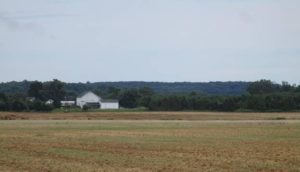
2017, August 6, Sunday — A view of the cuesta from the Union Transportation Trail in Upper Freehold, Monmouth County. The view is looking toward the Shore, so the abrupt rise in the terrain is seen. From the other side of the cuesta, the change in terrain is more gradual.
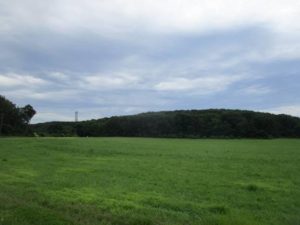 2017, August 6, Sunday — Another view of the cuesta – here, near the Horse Park of New Jersey in Upper Freehold, Monmouth County.
2017, August 6, Sunday — Another view of the cuesta – here, near the Horse Park of New Jersey in Upper Freehold, Monmouth County.
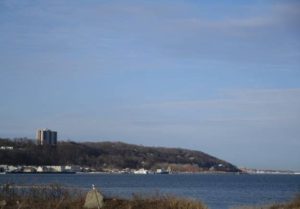
2016, January – Looking at the cuesta, about 200 feet above sea level, across Sandy Hook Bay from Sandy Hook.
BUTTERFLIES IN THE ZINNIA PATCH: Last year, my newspaper reporting travels took me to Bobby Laurino’s farm market in Colts Neck and Andy Capelli’s farm market in Middletown. I was amazed by the bees and butterflies attracted to their zinnia patches. Here was this abundance of pollinators and they were fun to watch. So, I did some research on zinnia – liking it because it is an annual, not a perennial I would be stuck with – and planted it in my garden, about 35 to 40 row feet. I wish I planted more! In recent days, I have spotted these butterflies: painted lady, “Vanessa cardui”; spicebush swallowtail, “Papilio troilus”; cabbage white, “Pieris rapae”; silver-spotted skipper, “Epargyreus clarus”; and monarch, “Danaus plexippus.” I try to become one with the zinnia patch, or at least letting the butterflies do their thing and me doing my thing, which allows me to get close to them and take great photographs.
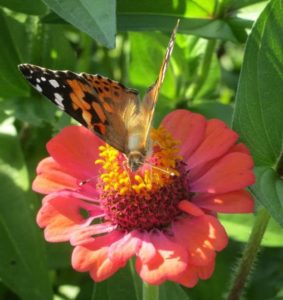
A painted lady butterfly in my zinnias.
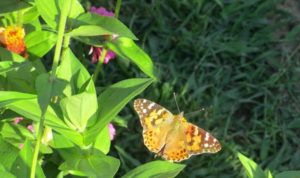
Painted lady in the zinnias.

Painted lady on a zinnia.
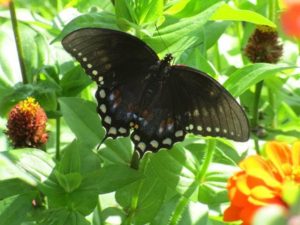
Spicebush swallowtail in the zinnias.
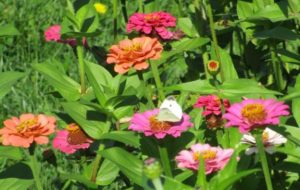 Cabbage white in the zinnias.
Cabbage white in the zinnias.
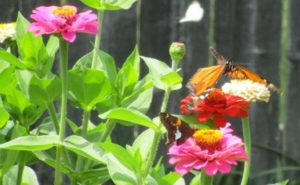
Silver-spotted skipper, lower, and monarch, upper, in the zinnias.
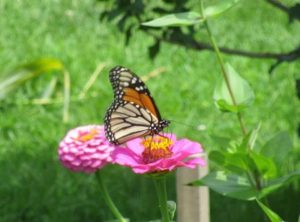
Monarch in the zinnias.
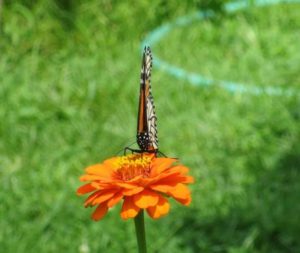
Monarch on a zinnia.
SOURCES, BUTTERFLIES: I love this Internet site of the North American Butterfly Association (NABA)-North Jersey Butterfly Club for identifying butterflies, http://www.naba.org/chapters/nabanj/butterflies.html.
GARDEN VOICE NO. 1, DEBBIE MANS: Debbie Mans reported, “We were just comparing notes at work on our gardens and we are all not seeing great results — split tomatoes, fizzled squash, slow on the tomatoes ripening, etc. This is in Monmouth County and Essex County. I am hearing more and more from others, too. You are not alone!” (Debbie is executive director and baykeeper for the New York-New Jersey Baykeeper environmental group based in Keyport, Monmouth County. Here is a profile I wrote of Debbie last year, http://tworivertimes.com/debbie-mans-midwesterner-with-jersey-sand-in-her-shoes/.)
NAVESINK RIVER BOAT RIDE: Debbie Mans’s New York-New Jersey Baykeeper group is sponsoring a Navesink River boat ride September 19, Tuesday, out of Atlantic Highlands, Monmouth County. Last year, I sailed with the Baykeeper on a Sunday afternoon on Raritan Bay and the Shrewsbury River – a great time! So, if free, consider the Navesink River ride. Monmouth County’s Navesink River, one of my favorite places in the Jersey Midlands as it flows along the cuesta emptying into the Shrewsbury River. For the Navesink River Sunset Eco Cruise.
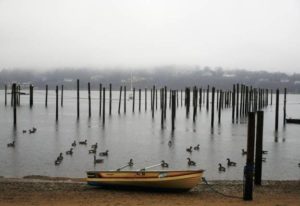
2015, December – Along the Navesink River.
GARDEN VOICE NO. 2, JACK MAHON: South Jersey gardener Jack Mahon and I recycle dehumidifier water, using it for gardening watering. But, this year, both Jack and I have noticed something – the heavy rains have left us with an overabundance of water. “The rain has been so heavy at times that the dehumidifier is way ahead of the trees’s need for water,” Jack said. Ditto. In recent days, my two barrels of water for the garden, totaling 50 gallons, have been full.
IN THE GARDEN AND YARD: I continued harvesting flowers, both zinnias and Knock Out roses, along with sweet corn. The fall crop is sprouting. And I watch the cucumbers and cantaloupe, hoping something comes about. The cantaloupes look OK as they grow, but the cucumbers seem to be victims of too much rain and I wonder if I will even get one to use.
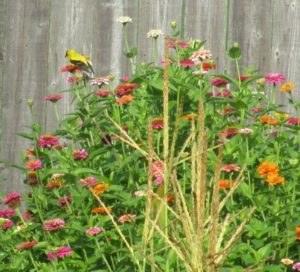
A male Eastern goldfinch, “Spinus tristis,” perched on a zinnia flower in the garden.
MONROE TOWNSHIP COMMUNITY GARDEN: I visited my lifelong hometown’s Community Garden and Park. It is a nice setting along the Millstone River. But I wish Monroe, which continues to develop heavily, would practice greener principles. For example, abandon magazine-photograph lawns and replace them with more productive organic gardens. Me, I am trying to go with as little lawn as possible – and my lawn is chemical-free. I know, I strive for an Old Monroe in a New Monroe whose population over its approximately 42 square miles is an estimated 45,000, a big difference from the estimated 5,000 when I was born in 1956.
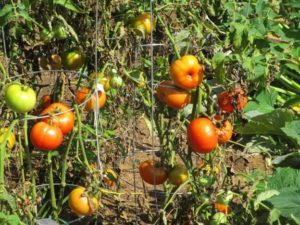
Tomatoes in the Monroe Community Garden and Park.
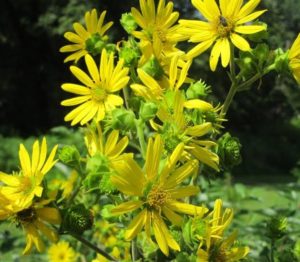
Flowers at the Monroe Community Garden and Park.
THE ECLIPSE OF THE SUN: On Monday, August 21, New Jersey will be treated to a partial solar eclipse. It begins at 1:22 p.m., peaks at 2:44 p.m., and ends at 4 p.m. DO NOT LOOK AT THE ECLIPSE UNLESS YOU HAVE SPECIAL PROTECTIVE EYEWEAR. (While I find the eclipse exciting, I do not want to take chances of looking up. So, I will take a nap, work in my cellar or garage, or follow the eclipse on the computer or television.) See https://eclipse2017.nasa.gov/.
CARDINAL PHOTO: The photo of a cardinal, “Cardinalis cardinalis,” in last week’s “Garden and Afield” drew a nice response from backyard neighbor Fran D’Aiello Rosuck. Fran and her husband, Ed, have been my family’s neighbor for about 40 years, or since about the time I went on my own after college. Then, after my parents, Joe Sapia Sr. and Sophie Onda Sapia, died, I, as an only child, moved back and took over the house. This summer, the outside of the house was remodeled. Fran said, “I always read that a cardinal is a visitor from Heaven. Your mom is probably saying the house never looked so good.” What a nice comment to find on my “The Jersey Midlands” page on Facebook.com.
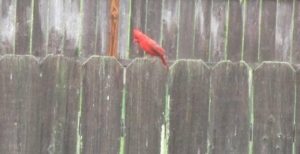
The cardinal at my garden. Actually, it is on backyard neighbor Fran D’Aiello Rosuck’s fence.
OCEAN TEMPERATURES: Atlantic Ocean temperatures on the New Jersey coast were in the range of about 75 to 77 degrees.
SUNRISE/SUNSET: For August 20, Sunday, to August 26, Saturday, the sun will rise about 6:15 to 6:20 a.m. and set about 7:40 to 7:50 p.m. For August 27, Sunday, to September 2, Saturday, the sun will rise about 6:20 to 6:25 a.m. and set about 7:30 p.m.
WEATHER: The National Weather Service forecasting station for the area is at http://www.weather.gov/phi/.
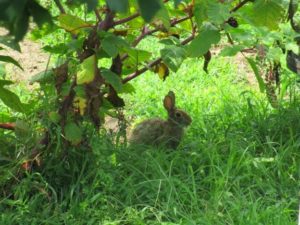 Rabbit, genus “Sylvilagus,” in the garden.
Rabbit, genus “Sylvilagus,” in the garden.
Joe Sapia, 60, is a lifelong Monroe resident. He is a Pine Barrens naturalist and an organic vegetable-fruit gardener. He gardens the same backyard plot as did his Italian-American father, Joe Sr., and his Polish-immigrant, maternal grandmother, Annie Poznanski Onda. Both are inspirations for his food gardening. Joe is active with the Rutgers University Master Gardeners/Middlesex County program. He draws inspiration on the Pine Barrens around Helmetta from his mother, Sophie Onda Sapia, who lived her whole life in these Pines, and his Grandma Annie. Joe’s work also is at @JosephSapia on Twitter.com, along with Facebook.com on the Jersey Midlands page.
Article and photos by Joe Sapia
Note: The yard references are to my house in the section of Monroe between Helmetta and Jamesburg in South Middlesex County. My yard is in a Pine Barrens outlier on the Inner Coastal Plain, the soil is loamy, and my neighborhood is on the boundary of Gardening Zones 6b (cooler) and 7a (warmer). Notes and photographs are for the period covered, unless otherwise noted.
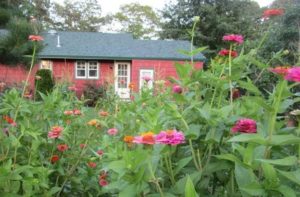
Looking across my backyard garden to the Knock Out roses and the house.
IN THE GARDEN: I began harvesting sweet corn – it tastes so good! I continued harvesting zinnia, mostly giving them away. Because zinnia are so beautiful, make nice bouquet gifts, and are so attractive to pollinators, I plan to really expand on growing them next year, taking over what is now a waste of lawn. I finished planting seeds for fall crops of beets, carrots, lettuce, and peas. Including early season, summer and fall crops, my garden is about 450 row feet. I began keeping a record of my harvest, so I have an idea how productive the garden actually is. Next year, I plan to keep the record from Day 1 harvest to Last Day harvest.
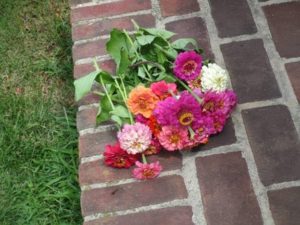
A zinnia bouquet heading to friends at my Sunday lunch stop, the Hightstown Diner.
A BAD GARDENING YEAR: I thought my garden was bombing out because of my lack of skills, but I continue to get reports of it not being a productive vegetable year. Paul Migut, a childhood friend and a gardening mentor of mine, checked in from South River, Middlesex County: “Agree, not one of the best garden years, here either.” Jack Mangano of Helmetta told me his family’s plot is not doing as good as it should. The weather has been fickle, one day monsooning, another day sunny and in the 90s – seemingly more fickle than a normal Jersey hot and humid summer with thunderstorms in the afternoon. I found a split cucumber, which, I suspect, was a victim of the rain – the rain forcing it to grow faster than it was able to maintain, resulting in it finally bursting.
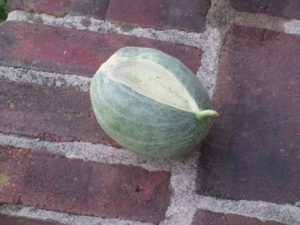
A split and ill-forming cucumber, an apparent victim of too much rain.
GARDENING TALK: Paul Migut reported on his garden: “Bush beans producing the best. Cucumbers growing well (made second batch of dill pickles in my grandmother’s 100-year-old old crock). Rutgers tomatoes getting bigger, but still green. Yellow (acid-free) almost ready to pick. Eggplants, too small to pick. Zucchini started out with a bang, until worm/borer devoured base of plant. By accident, I purchased a packet of turnip seeds, never grew these before, but wow- growing very well!”
ELSEWHERE AROUND THE YARD: I took off from feeding the birds this summer, letting them, instead, eat insects in the yard and serve as natural pesticides. So, I have not kept the eye I normally do on birds, mesmerized by them at the feeder. However, I did notice a bright yellow and black (male) Eastern goldfinch, “Spinus tristis”; a bright red (male) cardinal, “Cardinalis cardinalis”; and a favorite, a catbird, “Dumetella carolinensis” – the catbirds that keep me company in garden and afield. The toads are around, presumably helping control insects. I helped a toad out of a deep well of cellar window that was recently installed. I place a branch in the well; If a toad goes in, hopefully it can crawl out on the branch – because by the time I notice it, it may be too late. Of course, the friendly rabbits are around – letting me get close and probably eating up the garden. And the Knock Out roses, in their second bloom of the season, are getting better and better.
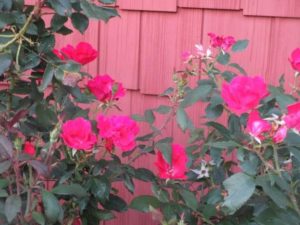
Knock Out roses are blooming beautifully in their second bloom of the season.
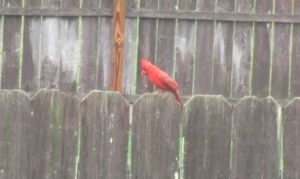
A male cardinal perched by the garden. A male, because it is bright red. The female is a dull brown.
ATTRACTING POLLINATORS, ZINNIA: While I love the beauty and no-fuss growing of zinnias, my real goal for planting them this year was to attract pollinators. This week, pollinators were around:

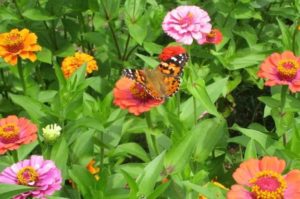
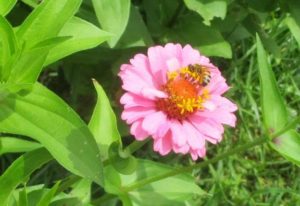
PERSEID METEOR SHOWER: The forecasted weather is not looking good, but take a chance and look up into the night sky on the overnights of August 11-12, Friday-Saturday, or August 12-13, Saturday-Sunday, the peak of the annual Perseid Meteor Shower. If there is a clear sky, an estimated 40 to 50 “shooting stars” will be visible per hour. The Earth will continue passing through Comet Swift-Tuttle’s path until August 24. See www.space.com/32868-perseid-meteor-shower-guide.html.
THE DRIVE-BY NATURALIST, ROADKILL: I was driving south on Route 539 in East Windsor, Mercer County, heading for the Assunpink Wildlife Management Area, when I came across an interesting sight -– vultures, both turkey, “Cathartes aura”, and black, “Coragyps atratus,” eating a roadkill deer, “Odocoileus virginianus.” It was an interesting study in nature, the death of one animal providing life-support to other wildlife. But it also was an interesting interaction between wildlife and humans – basically, traffic had to avoid the vultures, rather than the vultures making a serious attempt to avoid traffic. What did I take away from this scene? The importance of us helping living wildlife by moving dead wildlife off the roadway, because other birds may not be so lucky squaring off against traffic at a roadkill. A live bird could end up as roadkill.
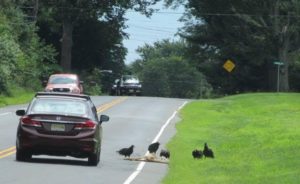
Notice how traffic has to move to avoid the vultures, while the vultures generally were carefree.
DRIVE-BY NATURALIST, NO. 2 – TURKEY VULTURES VS. BLACK VULTURES: Turkey vulture, red head, long tail. Black vulture, black head, short tail. (Note: I do not recall seeing a black vulture locally until probably the 1990s. They are a southern species that has moved northward.)
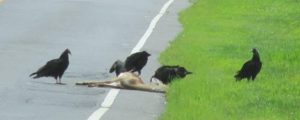
Turkey vulture, far left, with a red head and longer tail. Black vulture, far right, with short tail and black head.
CONNECTING WILDLIFE HABITAT: The state Department of Environmental Protection’s Endangered and Nongame Species Program has been working on a project, CHANJ, or Connecting Habitat Across New Jersey, which is aimed at creating wildlife habitat connectivity, since about 2012. The plan is to make a public push in 2018. CHANJ is looking to protecting habitat and connecting habitat through such things as land purchase, management of land, and safe wildlife passage at roadways. Roadway mitigation could include using culverts and bridges to have a safe pathway for wildlife to cross roads. The idea is have connectivity using core areas, which could be as little as 200 acres to as big as state regions such as the Highlands of North Jersey and, locally, the Pine Barrens. Core is “an area with high ecological integrity,” said Gretchen Fowles, a CHANJ biologist. “That’s a fancy way of saying it has little human influence,” she said. In Monmouth County, for example, beside the Pine Barrens as a region, CHANJ looks at cores as such places as the Navesink River, Manasquan River Reservoir, Shark River, Allaire State Park, the Turkey Swamp state- and county-owned properties, Monmouth Battlefield State Park, and Assunpink Wildlife Management Area. Then, the idea is to connect such areas as forest, field, freshwater wetlands, and coastal maritime habitats. “This might be kind of a last chance to keep areas protected and intact,” Fowles said. The CHANJ website is at http://www.state.nj.us/dep/fgw/ensp/chanj.htm. Also, a CHANJ video is at https://www.youtube.com/watch?v=6UbBcTUfz1U.
MUSHROOMS: Remember the adage, “There are old mushroom pickers. There are bold mushroom pickers. There are NO old AND bold mushroom pickers.” Me, 60-years-old, lifelong Jersey Midlands, from a maternal Polish-Slovak family of pickers going back here more than 100 years and I will comfortably pick only 2 mushroom species: honey (or “opienki,” as my Polski side calls them), genus “Armillaria,” and morels genus “Morchella.” My confidence in only those 2 comes from being taught by two smart, non-bold pickers. Because this time of year is popular for wild mushrooms: http://www.philly.com/philly/health/n-j-mushroom-poisonings-spike-some-potentially-life-threatening-20170808.html
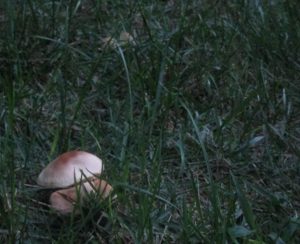
Inedible mushrooms in my yard.
“FALL” FOLIAGE: In the Pine Barrens around Helmetta, the beginning of the “fall” foliage usually is obvious in swamps beginning about July 15 to July 31. So, no surprise I have seen a few examples.
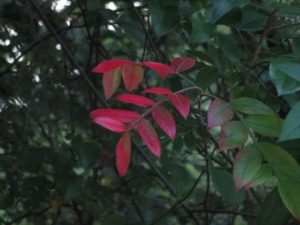
Changing colors in the Helmetta Pond wetlands.
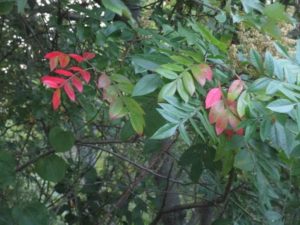
Another view of the changing colors in the Helmetta wetlands.
OCEAN TEMPERATURES: Atlantic Ocean temperatures on the New Jersey coast were in the range of about 76 to 78 degrees Thursday, August 10.
UPCOMING COUNTY FAIRS: Middlesex County Fair concludes August 13, Sunday, in East Brunswick, http://middlesexcountyfair.com/. Hunterdon County 4-H and Agricultural Fair, August 23, Wednesday, to August 27, Sunday, http://www.hunterdoncountyfair.com/.
OTHER UPCOMING: August 21, Monday, solar eclipse. September 9 and 10, Saturday and Sunday, 10 a.m. to 5 p.m., the state Department of Environmental Protection’s Wild Outdoor Expo at the Colliers Mills Wildlife Management Area, Jackson, Ocean County, WildOutdoorExpo.com.
SUNRISE/SUNSET: For Aug. 13, Sunday, to August 19, Saturday, the sun will rise about 6:05 to 6:15 a.m. and set about 7:50 p.m. to 7:55 p.m. For August 20, Sunday, to August 26, Saturday, the sun will rise about 6:15 to 6:20 a.m. and set about 7:40 to 7:50 p.m.
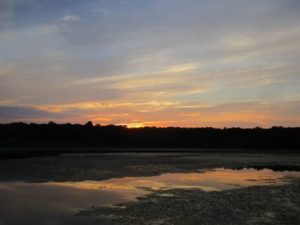
Sunset at Helmetta Pond.
WEATHER: The National Weather Service forecasting station for the area is at http://www.weather.gov/phi/.
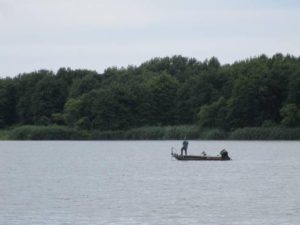
Assunpink at the Assunpink Wildlife Management Area, here in Monmouth County
Joe Sapia, 60, is a lifelong Monroe resident. He is a Pine Barrens naturalist and an organic vegetable-fruit gardener. He gardens the same backyard plot as did his Italian-American father, Joe Sr., and his Polish-immigrant, maternal grandmother, Annie Poznanski Onda. Both are inspirations for his food gardening. Joe is active with the Rutgers University Master Gardeners/Middlesex County program. He draws inspiration on the Pine Barrens around Helmetta from his mother, Sophie Onda Sapia, who lived her whole life in these Pines, and his Grandma Annie.
Joe’s work also is at @JosephSapia on Twitter.com, along with Facebook.com on the Jersey Midlands page.
Article and photos by Joe Sapia, except as noted
Note: The yard references are to my house in the section of Monroe between Helmetta and Jamesburg in South Middlesex County. My yard is in a Pine Barrens outlier on the Inner Coastal Plain, the soil is loamy, and my neighborhood is on the boundary of Gardening Zones 6b (cooler) and 7a (warmer). Notes and photographs are for the period covered, unless otherwise noted.

This scene, on August 2, Wednesday, at the Sears department store in New Brunswick, Middlesex County, kind of sums up this summer’s weather: alternating pouring rain and blue sky.
FARRINGTON LAKE: I love kayaking Farrington Lake on the boundary of South Brunswick, North Brunswick, and East Brunswick, all in Middlesex County. It is slender, about 3-1/2 miles long. Because there is so much forest lining the shores, it has a feel of being in the Adirondacks or some other place that is remote, rather than on the edge of suburbia as it is. This week, I did not kayak, but simply stopped to grab some quick photographs. Of course, the lake, created by the damming of Lawrence Brook basically between Davidson Mill Pond Park and Milltown, is beautiful, but I also saw a beautiful flower, purple loosestrife, “Lythrum salicaria.” The problem is purple loosestrife is non-native, highly invasive species, clogging the wetlands ecosystem. On the bright side, I was entertained by swallows. They fluttered around the lake, searching for bugs to eat.
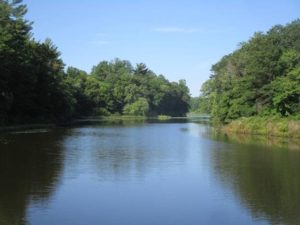
Farrington Lake, looking south toward Route 130 from the Church Lane bridge.
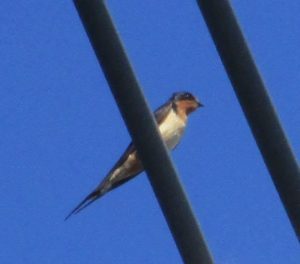
A barn swallow, “Hirundo rustica,” perches on a utility line above Farrington Lake.
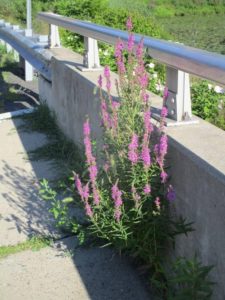
Purple loosestrife, even coming up through a crack in the sidewalk on the Church Lane bridge crossing Farrington Lake.
IN THE GARDEN: Cucumbers, cantaloupe, sweet corn, and tomatillos continue to grow, not yet ready to harvest. Remember me mentioning how I did not plant the tomatillos? Well, now, the garden is sprouting what appears to be gourds, which I did not plant. The zinnias continue to bloom wonderfully. And looking to the fall, I planted carrots. I went to Tony’s Farm and Garden Center in Robbinsville, Mercer County, and picked up more seeds for a fall crop: Detroit Red Medium Top Beets, Touchon Heirloom Carrots, Sugar Snappy Peas, Sugar Daddy Heirloom Peas, and Snowbird Peas, all Burpee brand.
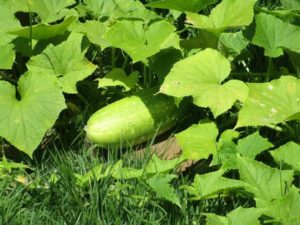
Here come the cucumbers. I place a brick underneath the cukes and mushmelons to keep them from having contact with the ground, leading to rot.
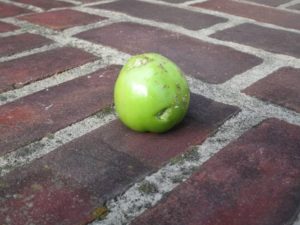
Which one of my yard friends bit into this green tomato?
GARDEN TALK: While at Tony’s Farm and Garden Center, I got talking to Tony Ciacco, the third generation of the Ciacco family to own and run the center. Tony mentioned the lack of bees in the environment, as we stood in amidst rows of flowers. Among those flowers, few, if any bees, which act as pollinators, flew around. In the past, the center would warn customers of bees flying around its greenhouses, Tony said. Later that afternoon, neighbor Tom DeRose and I stood in my zinnia patch. The zinnia patch noticeably has butterflies moving from flower to flower, but hardly any bees. We are in real trouble if we measure pollination by bees. Tom also mentioned his garden is having a bad year for carrots with a lot of green but little fruit. My carrots, too, are not doing great – some with clusters of nice carrots, some with lots of green but not good carrot production.
COLOR AT TONY’S: When I go to Tony’s Farm and Garden Center, I try to shoot photos because there is a lot of color in the plantlife.

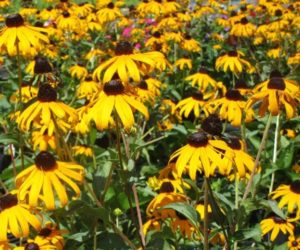
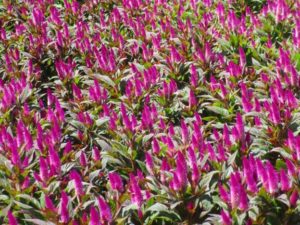
BALD EAGLES: I got a report of bald eagles, “Haliaeetus leucocephalus,” having a nest this season along the Raritan River just north of downtown New Brunswick. Also, the state Department of Environmental Protection confirmed a nest, which fledged one chick, in my hometown of Monroe. So, I have been keeping an eye out for eagles flying around near that nest, which is in the area of Route 33 and Applegarth Road/Butcher Road.
ORCHIDS IN THE PINE BARRENS: Faye Bray, a friend and outdoorswoman who lives in the main Pine Barrens, comes through again with beautiful reports of orchids. This time, the white-fringed, “Habernaria blephariglottis,” and the yellow-fringed, “Habernaria ciliaris.” Both were found recently in the Oswego Lake, Burlington County, area of the main Pine Barrens.
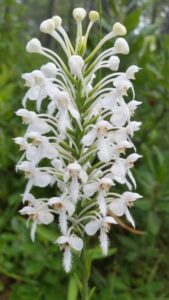
White-fringed orchid in the Oswego Lake area, Burlington County, of the Pine Barrens. (Photo copyright 2017 by Faye Bray.)
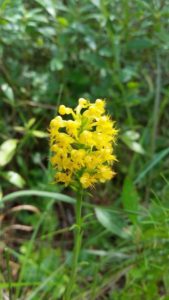
Yellow-fringed orchid in the Oswego Lake area of the Pine Barrens. (Photo copyright 2017 by Faye Bray.)
LOW MOISTURE IN THE AIR: When I am out in the garden, or the yard in general, I try to observe the world around me – basically the woods around me, The Swamp down the street, and the sky. As for the sky, on July 30, Sunday, Joey Slezak, a meteorologist and my go-to science guy in Helmetta, texted me, “Bluebird skies this morning! Low humidity!” Yes, the sky had that clear look to it because moisture was not clogging up the air. A great day to do yard work. I texted back, “Going out to cut lawn, camera in hand.” On days such as this, it feels as though one could reach up and touch airplanes passing by.

A JetBlue Airbus cruises by at about 240 knots at approximately 4,800 feet on its way from Fort Lauderdale, Florida, to Newark, Essex County. (How do I know the details on this aircraft? From following my new obsession, www.flightradar24.com.)
OBSESSION, NO. 2, WATERING THE GARDEN: In recent days, I have gone from daily watering (except when for days when it is raining) to more sporadic watering. If nothing else, I was worried the cantaloupe and sweet corn were getting too much water, especially because of the recent rain.
GRANDMA’S WATERING CANS: Normally, I water the garden using house water with hose and sprinkler. When I accumulate enough water in my water barrels, which can hold 20 gallons and 30 gallons, I use sprinkling cans I had around the house. At least one of them is Grandma Annie Onda’s. The other one, if not Grandma’s, was Ma and Pops’s. Those watering cans must date to the 1960s or earlier. One of them has a pretty severe leak. But they are still being put to good use. (Grandma, Ma, and Pops are deceased — Grandma in 1972, Ma in 1995, and Pops in 2006 — but their implements around the house are still being used by me.
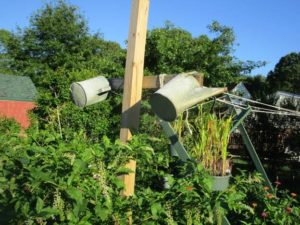
The old watering cans.
MORE WATERING WAYS: Jack Mahon – a South Jersey gardener, naturalist, and birder – shared his watering ways: “First, basement de-humidifier drains to bucket in sink. Milk jugs are filled from bucket. If we’re away, I just let it (the dehumidifier) drain directly into the sink. Next, jugs on back deck. Some have white caps, some pink. The pink ones would have a very diluted liquid plant food that I use in the first half of the season. Right now, though, they are 100 percent water. At end of August, I’ll start another very weak fertilizer routine, phosphorus & potash rather than the spring nitrogen-based. Finally, four of the crop, American beech, crepe myrtle, black pine, and willow oak. I only bother with hardy varieties that can overwinter in a cold frame.”
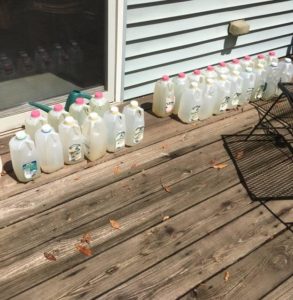
Jack Mahon’s recycled de-humidifier water to be used for potted trees he is raising. White caps mean pure water. Pink caps mean water diluted with plant food. (Photos supplied by Jack Mahon.)
BOOKS FOR THE JERSEY MIDLANDS NATURALIST, NO. 2: Years ago, I picked up a valuable book at New Jersey Audubon’s Owl Haven nature center at Monmouth Battlefield State Park in Monmouth County – “New Jersey Wild Plants” by Mary Y. Hough, a plant ecologist and taxonomist, 1983, Harmony Press, Harmony, N.J. The book lists plantlife alphabetically by its scientific name. So, most of us probably would need to use another source using common names, then check Mary’s book. As Rutgers University botanist David E. Fairbrothers wrote in the book’s preface, “This publication was designed as a New Jersey supplement for current field guides and technical manuals. …Included are all native and introduced species of club mosses, conifers, ferns, flowering plants, horsetails, quillworts, and spikemosses growing without cultivation in the state. …It is indeed a welcome addition for professional and non-professional biologists and/or naturalists, because it provides information about species for the entire state, much of which is not available or scattered in many sources, because of a lack of a “Manual of the Flora of New Jersey.” Mary Hough deserves our appreciation for having produced a useful information source about the interesting flora of a very floristic geographical area….” What I love about this book is it tells New Jersey bloom times, lists habitat and general state locations for finding the species, and gives a tidbit of more information such as the plant being poisonous or a little of the history in finding the plantlife. Owl Haven is long gone, but Hough’s book still proves invaluable. It is one of the most-used books in my outdoors collection. (Note: One, books mentioned in this series may be out of print. Two, Dr. Fairbrothers, now deceased, was a very informative and kind mentor of my pursuits in the Spotswood Outlier of the Pine Barrens.)
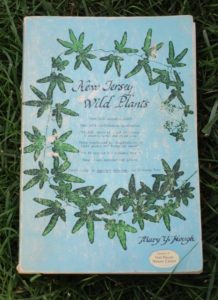
Mary Y. Hough’s “New Jersey Wild Plants”

Y. Hough’s “New Jersey Wild Plants.” Here, the listings for sheep laurel, “Kalmia angustifolia,” and mountain laurel, “Kalmia latifolia.”
MUSHROOMS: I have seen some chatter regarding the edibility of mushrooms on a Pine Barrens Facebook page I follow. I am 60-years-old and lifelong Jersey Midlands and I feel comfortable picking only two types of mushrooms. I will not identify them for this conversation because I do not want to confuse anyone on what is edible. So my basic advice, only feel safe eating a locally found mushroom if a COMPETENT picker OKs it. Remember the adage: “There are old mushroom pickers. There are bold mushroom pickers. There are no old AND bold mushroom pickers.”
CLOUDS: Over the last several months, we have been blessed with beautiful views of cloudy skies…
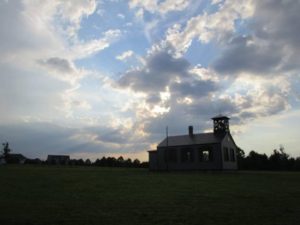
At the Dey Farm Historic Site in Monroe.
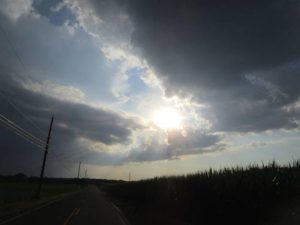
Farmland at the Applegarth section of Monroe.

At the Johnson and Johnson clock tower in New Brunswick.
IN THE YARD, ROSES: There seems to be a sporadic, but beautiful, bloom on the “Knock Out” roses in my backyard. So, I will call this a continuation of the second bloom of the season, rather than a third bloom. The rose bushes did get somewhat battered during the recent outside remodeling of my house that lasted from mid-June to late July. Perhaps that is the reason for sporadic blooming.
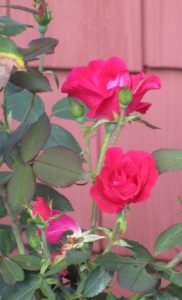
The “Knock Out” roses in bloom in the backyard.
OCEAN TEMPERATURES: Atlantic Ocean temperatures on the New Jersey coast were in the range of 73 to 76 degrees on Saturday, August 5.
UPCOMING COUNTY FAIRS: Middlesex County Fair, August 7, Monday, to August 13, Sunday, in East Brunswick, http://middlesexcountyfair.com/. Somerset County 4-H Fair, August 9, Wednesday, to August 11, Friday, in Bridgewater, http://www.somersetcounty4h.org/fair/. Hunterdon County 4-H and Agricultural Fair, August 23, Wednesday, to August 27, Sunday.
OTHER UPCOMING: There will be a solar eclipse August 21, Monday.
SUNRISE/SUNSET: For Aug. 6, Sunday, to August 12, Saturday, the sun will rise at about 6 to 6:05 a.m. and set about 8 to 8:05 p.m.
WEATHER: The National Weather Service forecasting station for the area is at http://www.weather.gov/phi/.
JOEY’S WORLD: On Saturday, August 5, I found one of my garden buckets filled with water and thought, When did it rain hard? But neighbor Tom DeRose informed me the neighborhood had a severe thunderstorm after midnight and before dawn. We did? Oh, boy, I must have pretty much slept through it.
SCREEN TENT: A few weeks back, I ordered a Coleman screen tent. I wanted a simple way to enjoy the backyard without mosquitoes biting me. I had to wait for the remodeling contractors to be gone, before I could regain control of my yard, including putting up the tent. What a buy for about $60 or so dollars. I did write much of this blog in the tent. Now, to find more time to enjoy the tent.
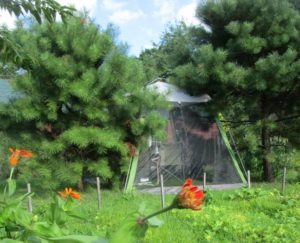
The screen tent nestled between two pitch pines, “Pinus rigida,” the food-flower garden, and lawn.
A PLAN FOR NEXT YEAR: Simply, as little lawn as possible. Translated, more space for growing food and zinnias, less grass for me to cut.
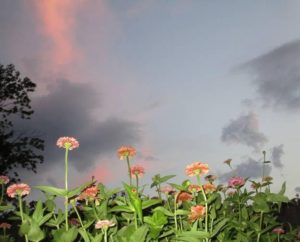
Beautiful zinnias in the garden and a beautiful sky in the background.
Joe Sapia, 60, is a lifelong Monroe resident. He is a Pine Barrens naturalist and an organic vegetable-fruit gardener. He gardens the same backyard plot as did his Italian-American father, Joe Sr., and his Polish-immigrant, maternal grandmother, Annie Poznanski Onda. Both are inspirations for his food gardening. Joe is active with the Rutgers University Master Gardeners/Middlesex County program. He draws inspiration on the Pine Barrens around Helmetta from his mother, Sophie Onda Sapia, who lived her whole life in these Pines, and his Grandma Annie. Joe’s work also is at @JosephSapia on Twitter.com, along with Facebook.com on the Jersey Midlands page. Copyright 2017 by Joseph Sapia
While the LRWP and other New Jersey non-profits are working hard to clean up our waters and secure clean, safe drinking water for future generations, EPA Administrator Scott Pruitt is working to roll back the Clean Water Act. The current administration is rushing through a repeal of the Clean Water Rule and we have until August 28 during public comment to try and stop it. It’s critical for your voice to be heard in D.C.
What is the Clean Water Rule?
In 2015, the previous administration clarified and finalized protections for streams and wetlands across the country. These safeguards protected the small streams that feed the drinking water sources for nearly 1 in 3 Americans. They protected wetlands throughout the nation that filter pollutants from water, absorb floodwaters, and provide habitat for countless wildlife. In fact, industry and other permittees asked for this clarification as an end to regulatory confusion about which of the country’s waterways the Clean Water Act protects. The rule was supported by millions of Americans.
The Clean Water Rule followed a robust public process. Before finalizing the Clean Water Rule in 2015, EPA held more than 400 meetings with stakeholders across the country and published a synthesis of more than 1,200 peer-reviewed scientific publications, which showed that the small streams and wetlands the Rule safeguards are vital to larger downstream waters.
What is this administration proposing?
Administrator Pruitt does not want to implement the Clean Water Rule. Instead, he plans to rush through the repeal of the Clean Water Rule this year, then propose and finalize a less protective rule in less than a year. President Trump signed an Executive Order instructing the EPA to propose a new rule based on former U.S. Supreme Court Justice Scalia’s opinion of which waterways the Clean Water Act protects. A rule following Scalia’s interpretation would result in drastic exclusions of wetlands and streams from protection; fewer than half of wetlands and fewer than 40 percent of streams would receive federal protection. If that scenario comes to pass, then the nation’s waters will be less protected than they were in 1975!
Who is opposing the Clean Water Rule?
Lobbyists for oil and gas producers, homebuilders, and farm bureaus.
What is at stake?
Our right to clean drinking water is in jeopardy. Rolling back the rule will result in the same regulatory confusion that resulted in broad-based calls for clarity about which of our nation’s waterways the Clean Water Act protects. Rolling back the rule is bad governance, bad for businesses who rely on regulatory certainty, and bad for our communities that deserve clean water.
How you can help
The LRWP has submitted this letter (8.16.17 – LRWP letter to EPA re CWA rules repeal) to Administrator Pruitt. You can help by submitting a request to stop the repeal of this important rule on or before Monday, August 28, 11:59pm EST. Submit your online comment to the Federal eRulemaking Portal to STOP THE REPEAL! Sample language below:
RE: Docket ID No. EPA-HQ-OW-2017-0203
Dear Administrator Pruitt:
The last thing we should do is weaken protections for clean water. I oppose the proposed repeal of the Clean Water Rule. Let the courts do their jobs and review the 2015 rulemaking.
This roll-back is dangerous. Clean water is the backbone of healthy communities and essential to a strong economy. Repealing this commonsense safeguard puts all of that at risk. The proposed repeal will remove Clean Water Act protections for the streams that feed the drinking water sources for more than 1 in 3 Americans. It will endanger 20 million acres of wetlands that provide habitat for wildlife throughout the nation. It could allow the pollution and destruction of the water resources small businesses like craft breweries and outdoor recreation companies rely on. Moreover, property values would be negatively impacted.
Repealing the Clean Water Rule is shortsighted and flies in the face of public opinion. More than 800,000 Americans supported the Clean Water Rule when it was proposed. It is grounded in science and the law. It is an essential tool to help us to get to goal of ensuring all of our waters are swimmable, fishable, and drinkable.
[Include your own thoughtful, compelling comment of how clean water is important to you]
Please stop the repeal process and get back to EPA’s mission – protecting human health and the environment.
Thank you for considering my concerns.
Sincerely,
[your name]
Lower Raritan Watershed, New Jersey
Article and photos by Joe Mish
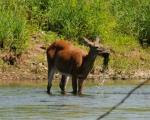

Dining at the underwater salad bar, this deer enjoys more than a mouthful of greenery, obtained by submerging its face in the water up to its ears.
August is a deep relaxing stillness in the never-ending cycle of renewable life. It is the moment after the final brush stoke is applied to an artistic masterpiece. Work that began anew, a year before, has reached a higher level of maturity in an infinite succession of seasonal effort.
The terminal end of each season can be a time of reflection, as an endpoint immediately prompts the thought of a beginning. August, however, is different, as there is an aura of timelessness created in an extended moment of satisfying exhalation; an arrival after a long journey.
Time is now suspended by desire. August is the moment we want to last. There is no desire for summer to end or feel the chill of winter sooner than scheduled. Mentally we drag our feet to slow the calendar, even assigning 31 days isn’t enough, and in response, time accelerates.
While the berries harvests of June and July have gone by, the plants that sent their energy to the fruit, now direct it to the roots and leaves in preparation for next berry season. The berry season may have been the highpoint for berry consumers but for the blackberry or dewberry plant, August is a finish line in a race to recover and maximize growth for next year’s crop.
The dark green leaves and vegetation, that dominate the high summer landscape, are noticeably different than the array of green tints seen in the spring. It is as if colors went through a maturation process independent of natural influences. Where the palest greens began to darken in color, as each successive tint accumulated, until it reached a deep forest green.
The summer greenery is not limited to plants and leaves dancing in the wind. Beneath the surface of the river, underwater grasses have reached maturity by late summer. In clear shallow water, the fast current animates long strands of flowing grasses, isolated in bundles across sections of sandy river bottom. Dark green grass sways alongside pony tails of Kelly green and gray green grass to cast a hypnotic spell on a passing paddler.
Deer relish these grasses and spend many a high summer day, faces submerged, full to their ears, in an effort to enjoy that cool mixed salad.
Blooming raspberry colored thistle, topped with flocks of hungry yellow goldfinch, teasel, goldenrod, strands of deep purple pokeweed berries and off-white Queen Anne’s lace, act as colorful bejeweled timepieces set among the greenery of August. Listen closely and you can even hear the ticking of that seasonal clock as black walnuts begin drop. The ticking is especially loud and shocking when a plum sized black walnut falls into quiet water on a calm, windless day, to spike a paddler’s heart rate.
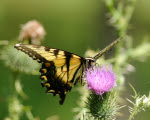
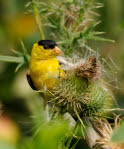
Goldfinch and tiger swallow-tail feed on the blooming thistle of late summer.
August can hardly keep a secret as it reveals a preview of things to come. Look closely and you can find isolated flashes of red and orange staghorn sumac, poison ivy and Virginia creeper. Even if you miss the visual clues, August provides an occasional chilly morning as a reminder that its moment of stillness is just an illusion.
The gold of August is revealed by its first two letters, au, the symbol for gold and awarded for achievement. The ‘gust’ or gusto represents the vigor of mature life that peaks in high summer.
Author Joe Mish has been running wild in New Jersey since childhood when he found ways to escape his mother’s watchful eyes. He continues to trek the swamps, rivers and thickets seeking to share, with the residents and visitors, all of the state’s natural beauty hidden within full view. To read more of his writing and view more of his gorgeous photographs visit Winter Bear Rising, his wordpress blog. Joe’s series “Nature on the Raritan, Hidden in Plain View” runs monthly as part of the LRWP “Voices of the Watershed” series. Writing and photos used with permission from the author.
Article by Joe Sapia
On Tuesday, I was talking to Kathy Clark, a biologist who has long been involved with the bald eagle restoration project for the state Department of Environmental Protection, and she surprised me with a question:
Do you know about the bald eagle nest at Route 33 and Applegarth Road?
Wow, no, I did not.
“It’s probably been there for two years,” said Clark, who works for the Endangered and Nongame Species Program in DEP’s Division of Fish and Wildlife.
But the state only found out about it in time to monitor the nest this year. And it fledged one chick! The nest is to appear in the state’s 2017 report, which will be out around the beginning of next year. Apparently, the nest will be listed as the “Upper Millstone” nest because of the Millstone River corridor in that area.
From 1970 to the early 1980s, New Jersey had only one confirmed nest — in the Delaware Bay area. In 2016, New Jersey had 172 nests. Of the 172, 150 had eggs, producing 216 fledglings.
The comeback of bald eagles, “Haliaeetus leucocephalus,” is attributable to the 1972 United States banning of DDT pesticide, which worked itself into the food chain and resulted in fragile eagle eggs. Also, in New Jersey, the DEP has done a considerable job with managing an eagles comeback.
Since the comeback era of eagles, Monroe has never had a confirmed nest. So, this is a rather big discovery – one proving there is a lot to save in Monroe environmentally and specifically in terms of open space. Otherwise, the nearest confirmed bald eagle nests to Monroe, based on the 2016 report, are in the areas of Cheesequake State Park/Old Bridge, East Brunswick/New Brunswick, Princeton, the Six Flags Great Adventure area, and Fort Dix. The state also believes there is a nest at the Assunpink Wildlife Management Area. Another nest is likely in the Old Bridge area, but the state lost track of that nesting pair in 2015.
Despite the comeback of the bald eagle, it remains in New Jersey an “endangered” breeder – that is, in immediate jeopardy as a breeder – and “threatened” in general – that is, in danger of becoming “endangered” if conditions deteriorate.
The Monroe nest will really be a test to see what the township and its residents are made of environmentally. I have not seen the nest, but know the property it is on. It is private property that looms for development. And the nest is incredibly close to existing development and we have seen how the Route 33-Applegarth Road intersection is developing.
As Clark noted, “It’s quite built-up.”
It is unknown why the eagles picked this spot, one that is not on a body of water, for example, for its preying on fish.
Clark said the eagles look for: “Is there a foraging area? Is there a tree that will support a nest in the long run?”
Or a utility tower, even.
The nests are huge, perhaps 4 or 5 feet in diameter, 2 to 4 feet deep – with the birds adding onto the nest each year. The largest documented eagle nest was 9-1/2 feet in diameter, 20 feet deep, weighing about 6,000 pounds, according to the National Eagle Center.
This nest is relatively close to Cranbury Lake, Hightstown Lake, Etra Lake, Perrineville Lake, and Jamesburg Lake, so there are bodies of water around.
Because eagle nests are so fragile – this one with the added development pressure around it – I am not giving out the exact location. One, there is no need to get close to the nest – think of it as the eagle’s bedroom, a private place. Two, knowing the nest is in the general area, people should have ample views of eagles flying over the area – and there are various wide-open views in the nest area. Plus, I suspect the sightings people are reporting – at Thompson Park, at the Monroe Library, around the Route 33-Applegarth Road area, one even on road-kill in downtown Jamesburg several days ago – are these birds. Three, there are severe federal penalties regarding human interaction with eagles. (It is illegal in general to even own an eagle feather.)
Mature eagles, about 30 inches in height, with a wingspan of almost 7 feet, are easy to spot – huge brown birds with white heads and white tail-feathers. But it takes eagles years to reach maturity, so they do not get the adult colors until they are 4- or 5-years-old.
What can we do?
One, if you know the location of the nest, do not publicize it.
Two, if you know the location of the nest, stay away from it – as in hundreds of feet away. Photo opportunities are better with flying eagles than nesting eagles.
Three, move road-kill off roadways. If the eagle decides to take advantage of road-kill, at least it will not get hit by a vehicle if the road-kill is off the roadway.
Four, think environmentally. Monroe’s new obsession with a magazine-photograph lawn around a McMansion on what was woods or farmland only a few years ago is ridiculous.
Five, put pressure on developers and government officials to go green.
Too bad the Township Council cut the open-space tax rate. It went from bringing in at estimated $1.8 million annually, down to an estimated $900,000. Had it stayed where it was, all that extra money would have come in, without a hike in taxes, for open space purchases.
As for the Monroe eagles, let them soar!
See https://www.allaboutbirds.org/guide/Bald_Eagle/id
See https://www.fws.gov/midwest/eagle/protect/index.html
Joe Sapia, 60, is a lifelong Monroe resident. He is a Pine Barrens naturalist and an organic vegetable-fruit gardener. Joe’s work also is at @JosephSapia on Twitter.com, along with Facebook.com on the Jersey Midlands page.
Article and Photos by Michele Bakacs
Ahoy There Matey! Rutgers Environmental Stewards Take Their First Boat Trip on the Raritan River
On May 3rd the Middlesex class of Rutgers Environmental Stewards took the water. This afforded them a rare opportunity to see the Raritan River up close by taking a 2 hour boat trip on the new R/V Rutgers. The R/V Rutgers is a new boat operated by the Department of Marine and Coastal Sciences. This 36 ft. (11 meter) aluminum landing craft is a 20 passenger vessel and supports a wide range of educational and scientific needs such as trawling, grab sampling, diving, water profiling, coring, AUV operations, etc. Faculty can reserve the vessel so students can get a first-hand look at the Raritan River ecosystem and the human impacts to the watershed.
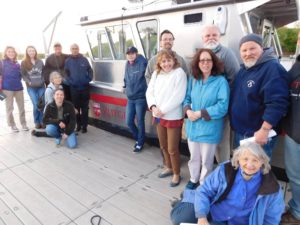
This is part of a larger effort by the Rutgers Collaborative for Research and Education to “Bring the River to your classroom” and works to support faculty efforts in engaging students and the community in Raritan River data and science through data activities.
The Rutgers Environmental Stewards program trains volunteers on important environmental issues affecting New Jersey and helps them make a difference in their own communities. The program consists of 60 hours of classes offered around the state on topics including habitat protection, climate change, geology, soil health, alternative energy, invasive plants, environmental policy, pollinators, and much more. Stewards complete a 60 hour internship of their choosing in order to become certified. Optional field trips are included. Anyone can become an Environmental Steward regardless of background.
The Stewards met the boat in Boyd Park in New Brunswick at the Class of 1914 Boathouse and were welcomed by the boat’s captain Chip Haldeman, and first mate Nicole Waite. Joining us on our trip was Dr. Heather Fenyk, Director of the Lower Raritan Watershed Partnership, and Dr. JeanMarie Hartman, Professor in the Department of Landscape Architecture. Heather and JeanMarie provided a rich history of the Raritan and identified points of interest including shale outcrop geologic formations, the Lenape Trail connection to the River, noted flora and fauna, as well as the industrial legacy of contaminated sites, old factories, and the Edgewater Landfill.
First mate Nicole taught the Stewards how researchers monitor water quality and trained them on collecting data using YSI water monitoring probes to test for dissolved oxygen, pH, temperature, and salinity. We also saw 2 Bald Eagles, countless Ospreys, Cormorants, and vast marshland. The salt marshes are mostly dominated by Phragmites australis, an invasive grass known as Common Reed, but we also saw native Spartina alterniflora (Salt Marsh Cordgrass) holding its own at the fringes of the saltmarshes.
Overwhelmingly the Stewards walked away with a new appreciation of this fantastic natural resource that most of us take for granted. Most people see the Raritan River as a place to avoid, to view from afar from the Garden State Parkway or Route 1 Bridge. This experience helped the Stewards better understand the River that lies in the heart of their community, and the importance of making sure it is cleaned up and protected.
Keep an eye on the LRWP blog for information about how to register for the Rutgers Environmental Steward class of 2018!
Drawing and article by Maya Fenyk (age 13)
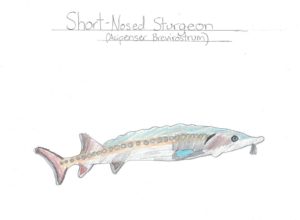
Short-Nosed Sturgeon
Hi! I’m Acipenser Brevirostrum, but you can call me Simon the Sturgeon. I am here to tell you about the many challenges I face as a two year old, juvenile short nosed sturgeon in the Raritan River. To start, I’d like to say how glad I am to be a sturgeon in 2017, even though my species has been federally endangered since 1973. Being a sturgeon living 120-150 years ago was even worse. Between the years 1870 and 1900, sturgeon were hunted for meat, but especially prized for their eggs for caviar.
We were nearly driven to extinction! Sturgeon are still feeling the effects 120 years later. Our population is only 12,000 in the waters New York and New Jersey, which truth be told is not a lot as female sturgeons lay 40,000 to 200,000 eggs per year. Caviar and hunting weren’t the only obstacle we have had to swim around to be able to survive. Another issue we face is river pollution. As bottom feeders we have a subterminal snout, we use our snout to vacuum our food from the substrate into our protractile mouth. This means that we pick up a lot of pollutants off of the substrate that isn’t food. We deserve to at least eat our meals of crustaceans, clams, mussels, snails, marine worms, flounder and plant matter, without having to guzzle down chemicals for dessert!
My species is considered a living fossil. We have been around for longer than 12,000 years and have retained a lot of primitive features that were common way back then, like our subterminal mouth and our barbels, a whisker like sensory organ. We have been in this area for longer than humans have, we have survived the caviar craze, and even industrial dumping that was common in Raritan for decades. That dumping residue along with the new stuff that has made its way to the Raritan (like expired medication, fertilizers and pesticides). These can turn into Endocrine System Disruptors (E.S.D) which damage our bodies and can either kill us or make us very sick. A lot of the pollutants also contain cadmium, arsenic are heavy metals that are extremely toxic.
Some ways you can help us live our natural life span of 35-70 years is by making sure to protect us from non-point source pollution. (That’s the pollution that is in stormwater runoff like pesticides, fertilizers, road salts and motor oil). You can make sure that streams have adequate buffers of plants and streams, and cleaning up our habitat will help. Also please let the NJDEP know if you see us. We are brown- gray fish with a yellow underbelly with a short rounded snout, heterocercal tail and a subterminal mouth, that is 18-22 inches long. Now I have to be going I see some yummy algae floating by. Though it isn’t fast food, but it sure moves pretty quick. Simon the sturgeon splashes out!
Dear Friends of the Lower Raritan Watershed –
It may be hard to believe, but many of the shorebirds that stop through the Lower Raritan Watershed have started their southern migration. Keep a look out for sanderlings, black-bellied plovers, red knots, least sandpipers and short-billed dowitchers. Knowing that our avian friends are already on their return trip home is a good reminder to get out in the field and enjoy the summer while it’s here!
We’ll celebrate the last last bit of summer at our next meeting, an after-work picnic on World Water Monitoring Day 2017. Join us in New Brunswick’s Boyd Park on Monday September 18 from 5:30-7:30pm, and bring your own picnic or something to share. We’ll supply beverages, paper products and dessert. Friends and family members welcome! (RSVPs requested). The evening will include water quality monitoring, project updates and a Raritan River “story slam” with coLAB Arts. Do you have a special Raritan River memory? Perhaps you swam in the Raritan as a kid, or have a story from a recent clean-up? Let us know! We are looking for 4-5 people to tell their stories on Sept 18. Storyteller confirms requested by August 31.
See you in the watershed,
Heather Fenyk, President
Lower Raritan Watershed Partnership
 2017, August 6, Sunday — Another view of the cuesta – here, near the Horse Park of New Jersey in Upper Freehold, Monmouth County.
2017, August 6, Sunday — Another view of the cuesta – here, near the Horse Park of New Jersey in Upper Freehold, Monmouth County. Rabbit, genus “Sylvilagus,” in the garden.
Rabbit, genus “Sylvilagus,” in the garden.


























































